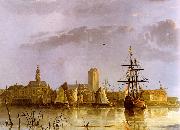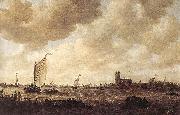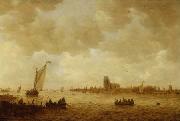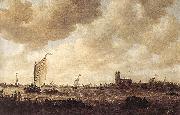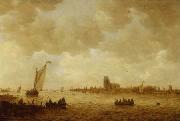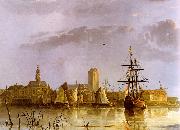Wholesale Oil Painting Reproductions No Minimum and Door to Door! |
|||||||||||
|
|
|||||||||||

|
|||||||||||
|
|
|
||||||||
All Aelbert Cuyp Oil Paintings |
||||||||
|
|
||||||||
|
|
||||||||
|
Artist Introduction: 1620-1691
Dutch
Aelbert Cuyp Locations
Painter and draughtsman, son of Jacob Cuyp. One of the most important landscape painters of 17th-century Netherlands, he combined a wide range of sources and influences, most notably in the application of lighting effects derived from Italianate painting to typical Dutch subjects. Such traditional themes as townscapes, winter scenes, cattle pieces and equestrian portraits were stylistically transformed and given new grandeur. Aelbert was virtually unknown outside his native town, and his influence in the 17th century was negligible. He became popular in the late 18th century, especially in England. |
||||||||
|
|
||||||||
|
View of Dordrecht Painting ID:: 681 |
1650 |
|||||||
Height Width |
INS/CM Quality |
|||||||
|
X |
| |||||||
|
|
||||||||
All Jan van Goyen Oil Paintings |
||||||||
|
|
||||||||
|
|
||||||||
|
Artist Introduction: Dutch Baroque Era Painter, 1596-1656
Jan van Goyen was born in Leiden on Jan. 13, 1596. Apprenticed from the age of 10, he had several masters. About 1617 he went to Haarlem to study with Esaias van de Velde, an important innovator in the Haarlem movement of realistic landscape painting. Van Goyen's works between 1621 and 1625 are sometimes hard to distinguish from those of his teacher. They are colorful, detailed views of villages and roads, usually busy with people, as in Winter (1621). It was Van Goyen's usual practice to sign or monogram and date his paintings. He traveled extensively through the Netherlands and beyond, recording his impressions in sketchbooks, occasionally with dates and often depicting recognizable scenes. Thus the chronology of his development is clear. His paintings of the late 1620s show a steady advance from the strong colors and scattered organization of his early works toward tonality and greater simplicity and unity of composition. By 1630 he was painting monochromes in golden brown or pale green; he played a leading part in the tonal phase of Dutch landscape painting. In 1631 Van Goyen settled in The Hague, where he became a citizen in 1634. The simplicity, airiness, and unification of his compositions continued to increase in his abundant production of dune landscapes, river views, seascapes, town views, and winter landscapes. The River View (1636) displays a river so open and extensive as to suggest the sea, with reflections that prolong the vast and luminous sky. In its monumentalization of humble structures and its composition built on a firm scaffolding of horizontal and vertical forces, it forecast at this early date developments that dominated landscape painting in the 1650s and later. In the Village and Dunes (1647) the traditional double-diagonal composition still exists, but it is dominated by horizontal and vertical accents. Stronger contrasts of light and dark replace the earlier tonality. In the last year of his life Van Goyen produced an eloquent new style, in which powerful forms stand out against the radiant sky and water in an exquisitely balanced composition (Evening Calm; 1656). The commission in 1651 to paint a panoramic view of The Hague for the Burgomaster's Room shows the high regard in which Van Goyen was held. He was enormously productive; well over 1,000 of his paintings still exist, and almost as many drawings. |
||||||||
|
|
||||||||
|
|
View of Dordrecht Painting ID:: 83103 |
Date between 1644(1644) and 1653(1653)
Medium Oil on canvas
Dimensions Height: 97 cm (38.2 in). Width: 148 cm (58.3 in).
cjr |
||||||
Height Width |
INS/CM Quality |
|||||||
|
X |
| |||||||
|
|
||||||||
All Jan van Goyen Oil Paintings |
||||||||
|
|
||||||||
|
|
||||||||
|
Artist Introduction: Dutch Baroque Era Painter, 1596-1656
Jan van Goyen was born in Leiden on Jan. 13, 1596. Apprenticed from the age of 10, he had several masters. About 1617 he went to Haarlem to study with Esaias van de Velde, an important innovator in the Haarlem movement of realistic landscape painting. Van Goyen's works between 1621 and 1625 are sometimes hard to distinguish from those of his teacher. They are colorful, detailed views of villages and roads, usually busy with people, as in Winter (1621). It was Van Goyen's usual practice to sign or monogram and date his paintings. He traveled extensively through the Netherlands and beyond, recording his impressions in sketchbooks, occasionally with dates and often depicting recognizable scenes. Thus the chronology of his development is clear. His paintings of the late 1620s show a steady advance from the strong colors and scattered organization of his early works toward tonality and greater simplicity and unity of composition. By 1630 he was painting monochromes in golden brown or pale green; he played a leading part in the tonal phase of Dutch landscape painting. In 1631 Van Goyen settled in The Hague, where he became a citizen in 1634. The simplicity, airiness, and unification of his compositions continued to increase in his abundant production of dune landscapes, river views, seascapes, town views, and winter landscapes. The River View (1636) displays a river so open and extensive as to suggest the sea, with reflections that prolong the vast and luminous sky. In its monumentalization of humble structures and its composition built on a firm scaffolding of horizontal and vertical forces, it forecast at this early date developments that dominated landscape painting in the 1650s and later. In the Village and Dunes (1647) the traditional double-diagonal composition still exists, but it is dominated by horizontal and vertical accents. Stronger contrasts of light and dark replace the earlier tonality. In the last year of his life Van Goyen produced an eloquent new style, in which powerful forms stand out against the radiant sky and water in an exquisitely balanced composition (Evening Calm; 1656). The commission in 1651 to paint a panoramic view of The Hague for the Burgomaster's Room shows the high regard in which Van Goyen was held. He was enormously productive; well over 1,000 of his paintings still exist, and almost as many drawings. |
||||||||
|
|
||||||||
|
|
View of Dordrecht Painting ID:: 84016 |
Date 1644(1644)
Medium Oil on panel
Dimensions 64.9 x 97.2 cm (25.6 x 38.3 in)
cjr |
||||||
Height Width |
INS/CM Quality |
|||||||
|
X |
| |||||||
|
|
||||||||
All Jan van Goyen Oil Paintings |
||||||||
|
|
||||||||
|
|
||||||||
|
Artist Introduction: Dutch Baroque Era Painter, 1596-1656
Jan van Goyen was born in Leiden on Jan. 13, 1596. Apprenticed from the age of 10, he had several masters. About 1617 he went to Haarlem to study with Esaias van de Velde, an important innovator in the Haarlem movement of realistic landscape painting. Van Goyen's works between 1621 and 1625 are sometimes hard to distinguish from those of his teacher. They are colorful, detailed views of villages and roads, usually busy with people, as in Winter (1621). It was Van Goyen's usual practice to sign or monogram and date his paintings. He traveled extensively through the Netherlands and beyond, recording his impressions in sketchbooks, occasionally with dates and often depicting recognizable scenes. Thus the chronology of his development is clear. His paintings of the late 1620s show a steady advance from the strong colors and scattered organization of his early works toward tonality and greater simplicity and unity of composition. By 1630 he was painting monochromes in golden brown or pale green; he played a leading part in the tonal phase of Dutch landscape painting. In 1631 Van Goyen settled in The Hague, where he became a citizen in 1634. The simplicity, airiness, and unification of his compositions continued to increase in his abundant production of dune landscapes, river views, seascapes, town views, and winter landscapes. The River View (1636) displays a river so open and extensive as to suggest the sea, with reflections that prolong the vast and luminous sky. In its monumentalization of humble structures and its composition built on a firm scaffolding of horizontal and vertical forces, it forecast at this early date developments that dominated landscape painting in the 1650s and later. In the Village and Dunes (1647) the traditional double-diagonal composition still exists, but it is dominated by horizontal and vertical accents. Stronger contrasts of light and dark replace the earlier tonality. In the last year of his life Van Goyen produced an eloquent new style, in which powerful forms stand out against the radiant sky and water in an exquisitely balanced composition (Evening Calm; 1656). The commission in 1651 to paint a panoramic view of The Hague for the Burgomaster's Room shows the high regard in which Van Goyen was held. He was enormously productive; well over 1,000 of his paintings still exist, and almost as many drawings. |
||||||||
|
|
||||||||
|
|
View of Dordrecht Painting ID:: 87252 |
between 1644(1644) and 1653(1653)
Medium Oil on canvas
cyf |
||||||
Height Width |
INS/CM Quality |
|||||||
|
X |
| |||||||
|
|
||||||||
All Jan josephsz van goyen Oil Paintings |
||||||||
|
|
||||||||
|
|
||||||||
|
Artist Introduction: Dutch , Leyden 1596-The Hague 1656
was a Dutch landscape painter. Van Goyen was an extremely prolific artist; approximately twelve hundred paintings and more than one thousand drawings by him are known. Jan van Goyen was the son of a shoemaker and started as an apprentice in Leiden. Like many Dutch painters of his time, Jan van Goyen studied art in the town of Haarlem with Esaias van de Velde. At age 35, he established a permanent studio at Den Haag (The Hague). Crenshaw tells (and mentions the sources) that Van Goyen's landscape paintings rarely fetched high prices, but he made up for the modest value of individual pieces by increasing his production, painting thinly and quickly with a limited palette of inexpensive pigments. Despite his market innovations, he always sought more income, not only through related work as an art dealer and auctioneer but also by speculating in tulips and real estate. Although the latter was usually a safe avenue of investing money, in Van Goyen's experience it led to enormous debts. Paulus Potter rented one of his houses. Nicolaes van Berchem became his pupil. In 1652 and 1654 he was forced to sell his collection of paintings and graphic art, and he subsequently moved to a smaller house. He died in 1656, still unbelievably 18,000 guilders in debt, forcing his widow to sell their remaining furniture and paintings. |
||||||||
|
|
||||||||
|
|
View of Dordrecht Painting ID:: 87874 |
1644(1644)
Medium Oil on panel
Dimensions 64.9 x 97.2 cm (25.6 x 38.3 in)
cyf |
||||||
Height Width |
INS/CM Quality |
|||||||
|
X |
| |||||||
|
|
||||||||
All Aelbert Cuyp Oil Paintings |
||||||||
|
|
||||||||
|
|
||||||||
|
Artist Introduction: 1620-1691
Dutch
Aelbert Cuyp Locations
Painter and draughtsman, son of Jacob Cuyp. One of the most important landscape painters of 17th-century Netherlands, he combined a wide range of sources and influences, most notably in the application of lighting effects derived from Italianate painting to typical Dutch subjects. Such traditional themes as townscapes, winter scenes, cattle pieces and equestrian portraits were stylistically transformed and given new grandeur. Aelbert was virtually unknown outside his native town, and his influence in the 17th century was negligible. He became popular in the late 18th century, especially in England. |
||||||||
|
|
||||||||
|
|
View of Dordrecht Painting ID:: 88838 |
1650
Medium English: oil on canvas
cyf |
||||||
Height Width |
INS/CM Quality |
|||||||
|
X |
| |||||||
|
|
||||||||
|
Prev Next
|
||||||||
|
|
||||||||
|
Related Paintings to Aelbert Cuyp :. |
||||||||
|
|
||||||||
|
CONTACT US |
